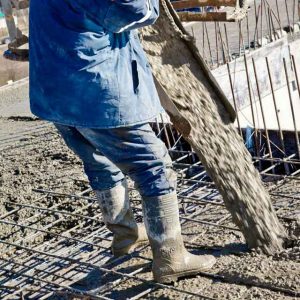GPR Concrete Scanning Principles and Theory
Principles and Theory Behind GPR Concrete Scanning
This overview of Principles and Theory touches on the physics of GPR concrete scanning. To this end, it is more of an abstract, discussion, and summary than an in-depth reference guide for GPR concrete scanning methods. For more on GPR theory visit Sensors & Software at The FAQs are provided by Sensors & Software of Canada, a great resource for GPR. To clarify, this discussion reflects my opinions and understanding of the physics, as it pertains to the discipline of geophysics.
How does a GPR Concrete Scanner Operate.
As the name implies, a concrete scanner uses a form of radar. Thus, the term ground penetrating radar. Radar uses radio waves. In other words, it transmits an electromagnetic pulse that radiates out from its antenna. The properties and physics that describe how the signal propagates are fairly well defined. Maxwell’s equations and Constitutive Equations define the manner in which an electromagnetic pulse propagates, as we know it.
Given these laws of physics, the electromagnetic pulse propagates through materials in various ways. At some point, the signal’s energy is too weak to measure at the concrete scanner. Before then, it propagates, while being absorbed, until it reflects and/or refracts off unlike materials. Reflection, refraction, and dispersion change the direction the signal travels. The signals vary over time. Under the right conditions, signals return to the concrete scanners antenna.
Conductivity, Dielectric Constants, and Scatter
Air is a great media for electromagnetic pulses. The pulses travel through air without a problem. In contrast, significant problems occur when the electromagnetic signals pass through materials other than air. Electromagnetic pulses for GPR pass through some materials at a faster rate. In addition, some materials absorb the energy better than other materials. Electrically conductive materials with high dielectric constants, like wet clay, often absorb the signal before it has a chance to reflect off an object and return to the receiver. In other words, electrically conductive materials, like new concrete, stop the electromagnetic pulse from doing its job, to image objects in the concrete.
Scattering of the electromagnetic GPR signal is a problem. The most likely situation occurs when one wishes to measure the thickness of the concrete slab or image targets below the bottom of a concrete slab. For example, the surface of the gravel base immediately below the slab is very rough and uneven. The base material is mostly large pieces of stone with little or no fine material to fill in the void spaces. Consequently, the jagged surface of the large pieces of stone cause the electromagnetic pulse to travel in many directions. Thus, effectively reducing the amount of signal returning back to the GPR receiver.
Antenna Configurations
For GPR, one or two antennas typically transmit and receive the electromagnetic pulse. While a monostatic system operates with one antenna, a two-antenna system is a bistatic configuration. In both cases, time and amplitude are recorded, amplified, processed, and finally displayed. These are all part of basic GPR instrumentation.
Why does GPR work for concrete scanning?
First, the principles and theory of GPR scanning tell us that the electromagnetic GPR signal should pass through cured or aged concrete without much difficulty. Secondly, the targets of interest are often made of metal, which easily reflect the signal back to the receiver. Metal is about twice as responsive at non-metallic targets. In other words, concrete is one of the best materials for GPR to work.
Some examples of when GPR fails to provide desirable results.
The principles and theory of GPR concrete scanning can not make up for a poor survey design or a minimum level of effort. While concrete is a great media for GPR to work in, the physics cannot make up for a lack of data. The page on GPR Cost Versus Level of Confidence addresses some of the concerns. In short, a minimum level of effort can easily lead to an accident. Straightforward results are easy to interpret. Under different circumstances, interpretations are not as easily made for more complex situations. Thus, an inexperienced operator may not appreciate what they are observing and miss a target of interest.
While metal reflects the GPR signal very well, other materials are less responsive, especially if the target is small in comparison to its depth of burial. Again, metal is very responsive; however, multiple layers of metal or very thick concrete slabs (blocks) may not yield a response that is easy to see in the GPR record. As a rough rule of thumb, one can image a metal target that is 1/12th the depth of burial. Since wire mesh responds well at depths great than 12 times it thickness, this is obviously a rough estimate. To repeat the previous discussion, the problem of too little signal, scattering, or a loss of signal from absorbtion can complicate the GRP results.
Summary of GPR Principles and Theory
As the slab thickness increases, the diameter and reflectivity of the target must increase. The depth of penetration for GPR concrete scanning is somewhat frequency dependent. While depths of penetration greater than 24 inches are always possible, antennas greater than or equal to 1000 MHz are likely to yield very desirable results for a concrete slab less than one foot thick. In addition, one can expect reasonably good results for a 12 to 18 inch thick concrete slab. By all means, other factors are a concern. Concrete scanning with a lower frequency 500 MHz antenna could easily penetrate many feet of concrete. But, the lower frequency 500 MHz antenna will have a more difficult time differentiating adjacent targets, smaller diameter targets, and targets with low reflectivity. Metal wire, metal rods, metal pipes, and metal conduits are highly reflective while plastic, PVC, voids, and non-metallic materials are less reflective.
Overall, the principles and theory of GPR scanning confirm that GPR can locate reinforcing material (rebar and mesh), detect post-tension cables, pipes, water lines, non-metallic conduits, and delineate voids. If at all possible, it is a good idea to follow any target found within the concrete to verify where it starts and where it ends. Often it is a better idea to map known features of concern over a larger area then it is to conduct a GPR survey over a small discrete area with the idea of avoiding a possible target. This increases your level of confidence that the correct feature was mapped out by the concrete scanner.






